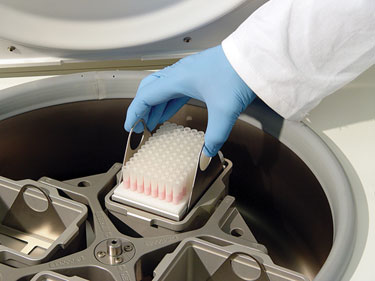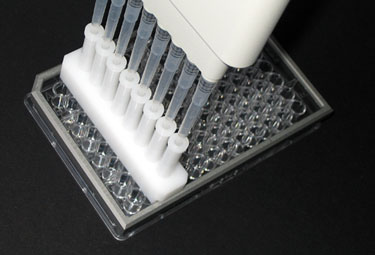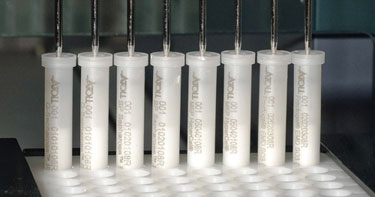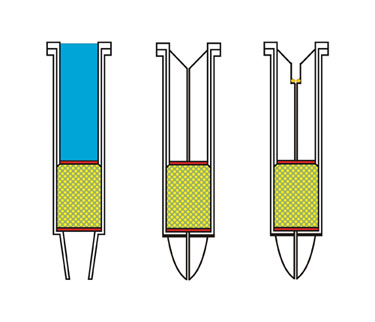August 1, 2008 (Vol. 28, No. 14)
Lothar Britsch Ph.D.
Tim Schroeder
Jurgen Friedle Ph.D.
Technique Has Applicability in Process Development and Product Monitoring
These days an assortment of preparative chromatography resins from different manufacturers are used for full-scale purification of biopharmaceuticals. The majority of these separation media are available in small prepacked columns for resin screening and parameter optimization.
Unlike in the world of analytical HPLC column formats, where standards have been in place for many years, standards have not yet been established for small-scale bio-chromatography. Therefore, until recently a comparison of results obtained from separations performed on different resins was impossible, mainly because the chromatograms obtained from the different column formats could not be directly superimposed. Such a comparison, however, is mandatory to reliably identify the most useful media for a particular process application.
Atoll recently introduced a small-scale column system that contains multiple bioprocess resins prepacked to defined compression into uniform column dimensions. MediaScout MiniColumns are compatible with standard 96-well microplates and allows for selected columns to be individually arranged into any of the 96 positions in the corresponding base plate. Thus, columns can be individually replaced and rapidly rearranged according to experimental requirements.
MediaScout is unique in that it introduces standardized column dimensions for small-scale bio-chromatography independent of resin manufacturers. A typical configuration for resin screening comprises 12 different resins arranged in rows of eight identical columns on one plate.
MediaScout can handle multiple samples in parallel in a variety of bio-chromatographic separations. The miniaturized column system provides three operational modes (Figure 1) including spin mode (CentriColumns), positive liquid-displacement (PLD) mode (PipetColumns), and a mode for liquid-handling workstations (RoboColumns).
For all these modes, the inner diameter is generally kept at 5 mm, however several fixed-bed heights are available (2.5, 5, 10, 30 mm) to comply with specific separation requirements. As a result, column volumes between 0.05 and 0.6 mL can be realized.
CentriColumns generally run at low angular acceleration, between a few hundred and 3,000 rpm. Also, capillary forces prevent them from running dry. In contrast to the constant flow rate achieved in PLD-mode columns, the flow rate in CentriColumns depends on the mass of the liquid above the top filter plate. During centrifugation this volume is continuously decreasing; the flow rate also slows down until it hits zero as the liquid level reaches the top filter plate.
CentriColumns can routinely run up to 384 columns simultaneously in a centrifuge (Figure 2). PipetColumns (Figure 3), on the other hand, are dedicated to method development on the bench prior to method transfer to the fully automated RoboColumn (Figure 4) system.
The chromatographic performance of MediaScout MiniColumns in small-scale protein separations has been shown to be equal to traditional columns running sequentially in a chromatography system. With the exception of size exclusion chromatography, which requires rather long columns, any chromatographic mode—ion exchange, hydrophobic interaction, immobilized metal chelate, and affinity chromatography—can be readily applied in the MiniColumn system.
In addition to the column format advantages, the MediaScout MiniColumn system also offers parallel-column operation. Dedicated liquid-handling workstations using positive liquid-displacement dispensers can individually control flow rates in RoboColumns for each of the eight simultaneously running columns.
Fractions are collected automatically into standard microplates or deep-well plates by robot-controlled positioning of the receiver plates underneath the fixed RoboColumn array. Subsequent movement of these plates into an integrated plate reader allows fully automated data acquisition and even sample processing. For example, fractions containing the desired product can be identified and automatically submitted for further purification or analytical measurements.
Applications for MediaScout MiniColumns are numerous and include samples that must be processed by real chromatographic separation quickly and/or where separations should be carried out in a fully automated procedure. Examples include sample prep (e.g., concentration by ion-exchange chromatography, affinity adsorption, de-salting), screening of cell culture supernatants for recombinant mAbs or other products, in-process monitoring of protein products during fermentation, particularly for the rapid analysis of multiple samples for the estimation of the optimal harvest time, resin screening and rapid 2-D parameter optimization in the development of individual process chromatography steps, and a wide variety of diagnostic applications.

Figure 1

Figure 2

Figure 3

Figure 4
Lothar Britsch, Ph.D., was formerly director of product development,
Tim Schroeder is biotech engineer, and Jürgen Friedle, Ph.D. (j.friedle@
atoll-bio.com), is marketing and sales director at Atoll.
Web: www.atoll-bio.com.







